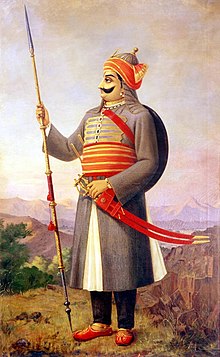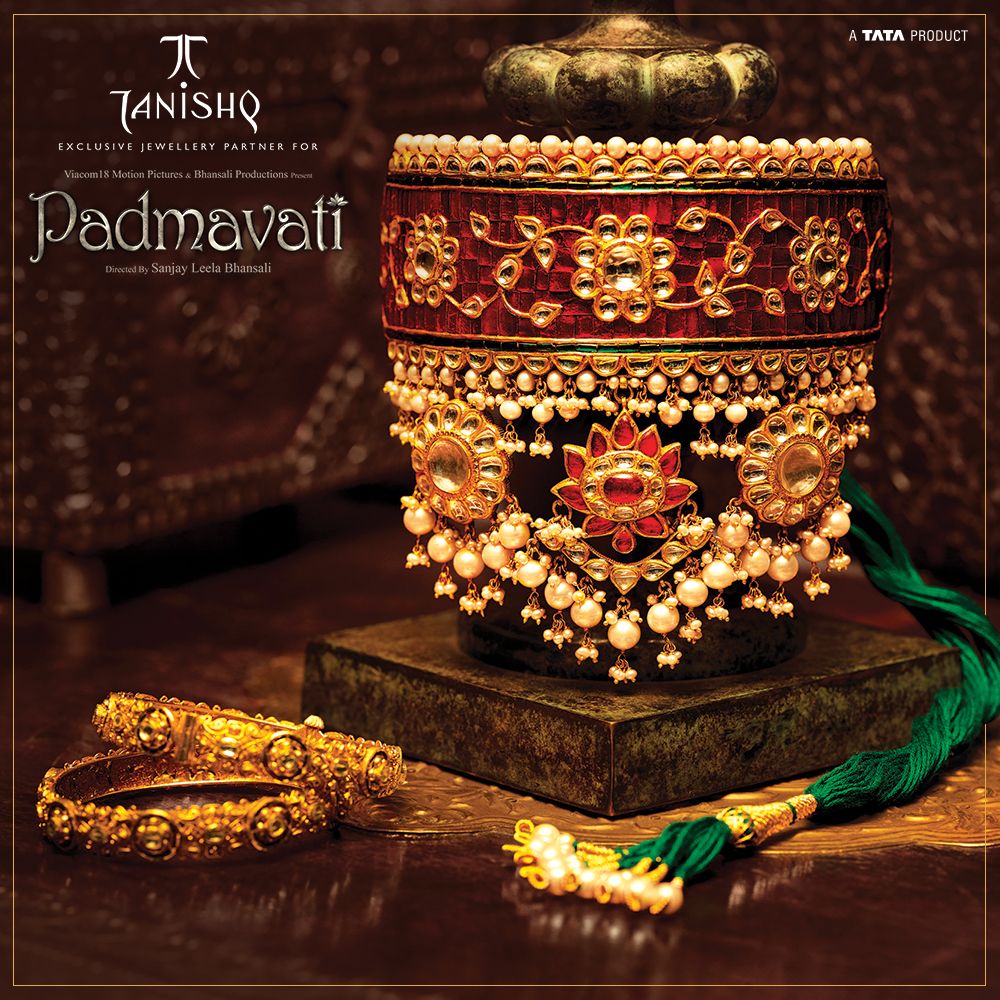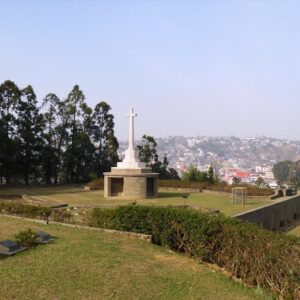Pratap Singh I (Hindi pronunciation: [Mahārāṇā pratāp] ; 9 May 1540 – 19 January 1597), popularly known as Maharana Pratap, was a king of Mewar, a region in north-western India in the present-day state of Rajasthan. He is notable for leading the Rajput resistance against the expansionist policy of the Mughal Emperor Akbar including the Battle of Haldighati and Battle of Dewair which have turned him into a folk hero.
Early life and accession
Maharana Pratap was born to Udai Singh II of Mewar and Jaiwanta Bai in 1540, the year in which Udai Singh ascended to the throne after defeating Vanvir Singh. His younger brothers were Shakti Singh, Vikram Singh and Jagmal Singh. Pratap also had two stepsisters: Chand Kanwar and Man Kanwar. His chief consort was Maharani Ajabde Bai Punwar of Bijolia. Their eldest son was Amar Singh I. He belonged to the royal family of Mewar.[10] After the death of Udai Singh in 1572, Rani Dheer Bai Bhatiyani wanted her son Jagmal to succeed him but senior courtiers preferred Pratap, as the eldest son, to be their king. The desire of the nobles prevailed and Pratap ascended the throne as Maharana Pratap, the 54th ruler of Mewar in the line of the Sisodia Rajputs. He was crowned in Gogunda on the auspicious day of Holi. Jagmal swore revenge and left for Ajmer, to join the armies of Akbar, and obtained the town of Jahazpur as a Jagir as a gift in return for his help.
Military career
Background
In stark contrast to other Rajput rulers who accommodated and formed alliances with the various Muslim dynasties in the subcontinent, by the time Pratap ascended to the throne, Mewar was going through a long-standing conflict with the Mughals which started with the defeat of his grandfather Rana Sanga in the Battle of Khanwa in 1527 and continued with the defeat of his father Udai Singh II in Siege of Chittorgarh in 1568. Pratap Singh, gained distinction for his refusal to form any political alliance with the Mughal Empire and his resistance to Muslim domination. The conflicts between Pratap Singh and Akbar led to the Battle of Haldighati.
Battle of Haldighati
Main article: Battle of Haldighati
The Siege of Chittorgarh in 1567-1568 had led to the loss of the fertile eastern belt of Mewar to the Mughals. However, the rest of the wooded and hilly kingdom in the Aravalli range was still under the control of Maharana Pratap. Mughal Emperor Akbar was intent on securing a stable route to Gujarat through Mewar; when Pratap Singh was crowned king (Maharana) in 1572, Akbar sent a number of envoys, including one by Raja Man Singh I of Amer, entreating him to become a vassal like many other rulers in Rajputana. When Pratap refused to personally submit to Akbar and several attempts to diplomatically settle the issue failed, war became inevitable.
The forces of Pratap Singh and Mughal and Rajput general Man Singh met on 18 June 1576 beyond a narrow mountain pass at Haldighati near Gogunda, modern day Rajsamand in Rajasthan. This came to be known as the Battle of Haldighati. Pratap Singh fielded a force of around 3000 cavalry and 400 Bhil archers. Man Singh commanded an army numbering around 10,000 men. After a fierce battle lasting more than three hours, Pratap found himself wounded and the day lost. He managed to retreat to the hills and lived to fight another day. The Mughals were victorious and inflicted significant casualties among the forces of Mewar but failed to capture Maharana Pratap.
Haldighati was a futile victory for the Mughals, as they were unable to kill or capture Pratap, or any of his close family members in Udaipur. While the sources also claim that Pratap was able to make a successful escape, Man Singh managed to conquer Gogunda within a week after Haldighati then ended his campaign. Subsequently, Akbar himself led a sustained campaign against the Rana in September 1576, and soon, Gogunda, Udaipur, and Kumbhalgarh were all under Mughal control.
Post-Haldighati Mughal invasions
Main article: Shahbaz khan’s invasions of mewar
Shahbaz Khan Kamboh led multiple invasions that resulted in the subjugation of key areas in Mewar, such as Kumbhalgarh, Mandalgarh, Gogunda, and Central Mewar, bringing them permanently under Mughal rule. The Mughal Empire established its supremacy in Mewar after Shahbaz Khan’s invasions. This ultimately led to a significant weakening of Pratap’s power, forcing him to retreat to his hilly abode.
Reconquest of Mewar
Maharana Pratap Memorial in Dewair for the battle of 1582.
Battle of Dewair (1582)
Mughal pressure on Mewar relaxed after 1579 following rebellions in Bengal and Bihar and Mirza Hakim’s incursion into the Punjab. After this Akbar sent Jagannath Kachhwaha to invade Mewar in 1584. This time too Mewar army defeated Mughals and forced them to retreat. In 1585, Akbar moved to Lahore and remained there for the next twelve years watching the situation in the north-west. No major Mughal expedition was sent to Mewar during this period. Taking advantage of the situation, Pratap recovered some of his territories at Mewar (except its former capital), and Mandalgarh.
Patronage of art
Maharana Pratap’s court at Chavand had given shelter to many poets, artists, writers and artisans. The Chavand school of art was developed during the reign of Rana Pratap. He also had renowned artists like Nasiruddin in his court.
Revival of Mewar
Maharana Pratap took refuge in the Chappan area and started attacking the Mughal strongholds. By 1583 he had successfully captured western Mewar, which included Dewar, Amet, Madariya, Zawar and the fort of Kumbalgarh. He then made Chavand his capital and constructed a Chamunda mata temple there. The Maharana was able to live in peace for a short time and started establishing order in Mewar. The Mughals shifted their attention to Punjab and other north-western provinces after Jaganath Kachwaha’s invasion of Mewar. Pratap took advantage of this situation to attack the Mughal occupied areas of Mewar and captured thirty-six Mughal outposts. Udaipur, Mohi, Gogunda, Mandal and Pandwara were some of the important areas that were recaptured from this conflict. According to the 1588 inscription near Jahazpur, the Rana gave the lands of Pander to a trusted follower called Sadulnath Trivedi. G.N. Sharma claims that the Pander inscription is proof that the Rana had occupied north-eastern Mewar and was granting lands to those who had been loyal to him. From 1585 till his death, the Rana had recovered a large part of Mewar. The citizens who had migrated out of Mewar started returning during this time. There was good monsoon which helped to revive the agriculture of Mewar. The economy also started getting better and trade in the area started increasing. The Rana was able to capture the territories around Chittor but could not fulfill his dream of capturing Chittor itself.
Death
Reportedly, Pratap died of injuries sustained in a hunting accident, at Chavand on 19 January 1597, aged 56. He was succeeded by his eldest son, Amar Singh I. On his death bed, Pratap told his son never to submit to the Mughals and to win Chittor back.
Legacy
Statue of Maharana Pratap in City Palace, Udaipur.
Maharana Pratap is a prominent figure in both folk and contemporary Rajasthani culture and is viewed as a celebrated warrior in that state, as well as in India as a whole.
Historian Satish Chandra notes –
“Rana Pratap’s defiance of the mighty Mughal empire, almost alone and unaided by the other Rajput states, constitute a glorious saga of Rajput valour and the spirit of self sacrifice for cherished principles. Rana Pratap’s methods of guerrilla warfare was later elaborated further by Malik Ambar, the Deccani general, and by Emperor Shivaji”.
Bandyopadhyay also seconds Satish Chandra’s view with the observation that
Pratap’s successful defiance of Mughals using guerrilla strategy also proved inspirational to figures ranging from Emperor Shivaji to anti-British revolutionaries in Bengal.
In 2007, a statue of Maharana Pratap was unveiled by former President Pratibha Patil in the Parliament of India.













Reviews
There are no reviews yet